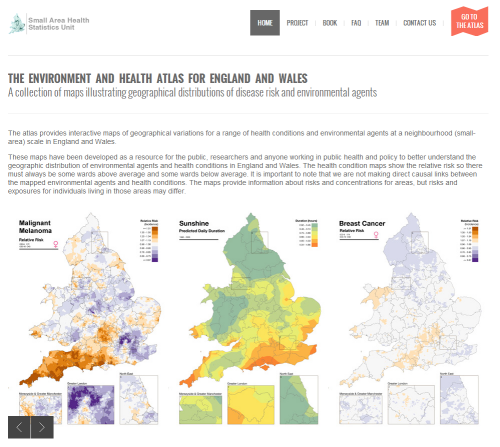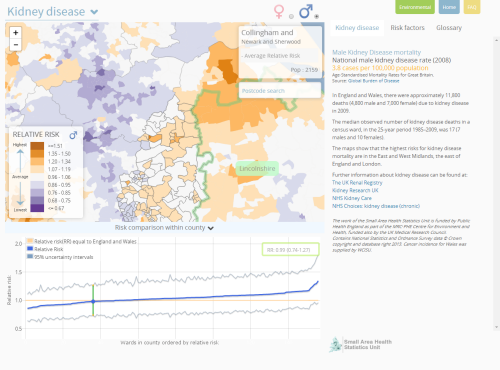 Click the image to go to the atlas web site
Click the image to go to the atlas web site
Mapping health and disease is often fraught with difficulties. Data is often aggregated to a resolution that doesn’t really provide much insight; is lacking a temporal dimension that is important to identify trends; or is not able to be published due to patient confidentiality issues. What we tend to see are over-generalised maps or snap-shots of a partial story that then get misconstrued in terms of what they might reveal, or which paradoxically seek to infer some outcome that the data might not support.
The Small Area Health Statistics Unit at Imperial College London has been researching patterns of health and disease for several decades. As a research grouped backed by the UK Medical Research Council and Public Health England they have unique access to detailed health data both at a fine resolution and across multiple years which they have been researching to better understand patterns of health and disease. The ability to publish the results of research is often restricted to scientific papers but this new atlas for the first time brings to life much of their effort in this area of scientific endeavor for the public and policy makers.
Kidney disease, an example atlas page. Click image to view online.
The atlas is the result not only of the 20+ years of research that has gone into understanding patterns of health and disease but also the 7 years it has taken to bring it to light as a publication. Navigating the complexities of working with this type of data and producing a worthwhile publication are not inconsiderable. This is a significant and monumental achievement. It combines data from many different sources over many years and the maps are not only well designed thematics but represent considerable analytical work in their production. This isn’t just mapping numbers, it’s analysing vast amounts of information in a statistically rigorous fashion and preparing maps that summarize the results succinctly. They are authoritative and are exemplars in treading that fine line between ensuring data privacy while revealing worthwhile information.
Many of the maps deal with hugely sensitive topics but they do so in a mature and considerate fashion. The online atlas is clean, modern and allows people to access the work through an efficient, unencumbered user interface. Each map allows users to view female or male patterns, to zoom in, rollover to see administrative boundaries and labels and to click to reveal detailed graphs. So many elements of the maps are linked. As you move across the map, the graph updates, there is a simple statment of above or below averahe that updates and even the legend brings the class into focus. These are all small but very effective controls that give the work a cartographic polish. The side panel is reserved for interpretative text and further information – critical to ensuring that the map’s message is not taken out of context. There’s even a set of risk factors to enable viewers to understand patterns in a socio-economic context and a glossary that explains medical and statistical terms clearly. This sort of attention to detail is too often missing from modern maps.
Making this work freely and openly available in map form is a triumph and sets the standard for online atlases of health for years to come. In many ways the online version may well cannibalize the potential sales market of the print version, itself a beautifully constructed print atlas but that alone is testament to the prime motive of this work. It’s data about the public, mapped for the public. The work has gained many plaudits and rightfully so.


